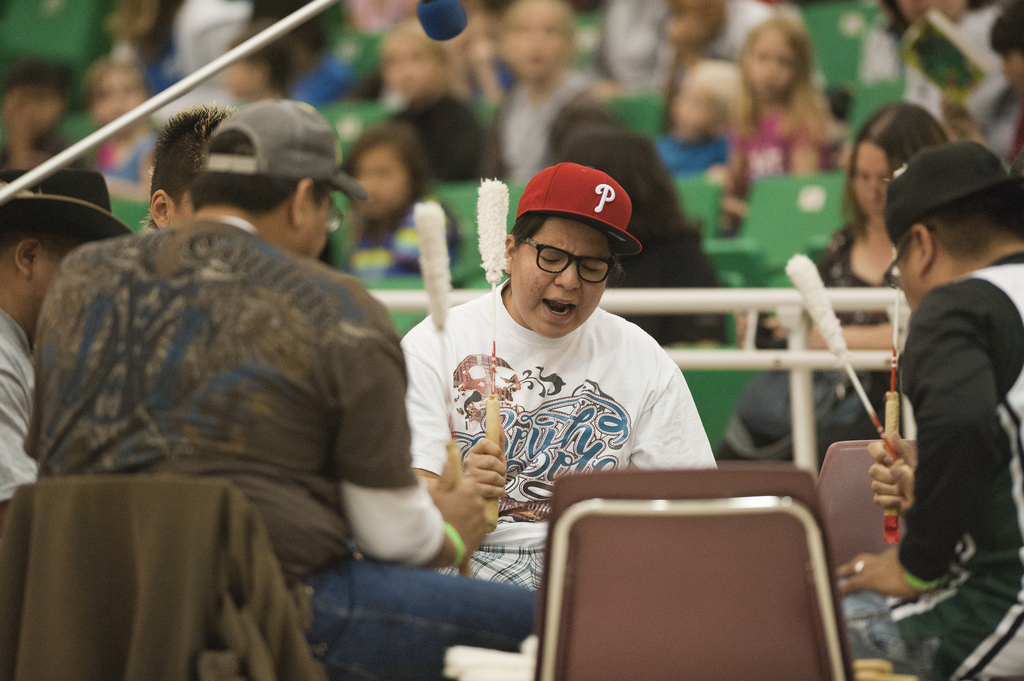Geronimo, Crazy Horse, Chief Joseph
Jesus, I wanna be the poet who writes about the powwows
the first one to describe how the smell of sweetgrass
trails behind the Indian dancer with his long dark hair,
eagle feathers swirling in soft curls on his bustle,
and how the jingles on his feet
laced tightly to fur leggings shake and ring, announcing his presence
as he walks to concessions and orders a pepsi and drinks it in silence,
his war paint unsmudged, his dark eyes heroic.
Powwows are an essential part of Native tradition today. They are one of the many testaments to the fact that we have inherited a living culture which moves and breathes to the rhythm of ancient drums. Many Tribes across the country host inter-tribal powwows each year where dancers from many nations come to share in the community and regality of Native-style dance, and to compete for prize money.Every powwow begins with a Grand Entry, usually held at twelve o’clock, with a second Grand Entry at seven o’clock. The drum beats start slow, as Golden Age dancers from every dance style lead the lines. As younger dancers enter the circle, the beat begins to accelerate. All around, flashy colors, bold designs, and eagle feathers twirl, while the rhythm of the host drum and the rising vocals of practiced singers create an ambience of victory.
Following the Grand Entry, there are competition dances. Male and female dancers have the opportunity to compete with others in their age and division. For male dancers, some of the competition dance styles are traditional, southern, fancy, and grass dance. For female dancers, some of the styles are traditional, southern shawl, fancy shawl, and jingle. Besides the fact that male and female dancers rarely compete with each other, except on teams, men and women are segregated by the fact that only male dancers wear bells. Because of this, female dancers use shiny, twisted Copenhagen can lids which they sew close together to create a shuffling sound which mimics a bell.
But there is more to powwows than dancing. While it is the show of many sovereign peoples displaying national pride through the use of bright regalia and fancy dances that brings spectators to powwow grounds, there are also other attractions that keep them. Merchant booths are lined up all around selling goods, many of which are traditional and Native. Some booths target dancers as customers, selling regalia items which are hard to find other places. Other booths sell delicious food, such as frybread, Indian tacos, homemade stew, or lemonade.
Powwows are an essential component of modern-day Native culture. In some ways, they display the tradition, beauty, respect, and honor of the past. In others, they reflect the ever-changing culture through new dances and songs. And in all ways, they create a sense of community and belonging between many tribes, tongues, and nations.
Special Thanks:
Misty Lynn Ellingburg (Shoalwater Bay) is a student at SeattlePacific University, majoring in English (concentration Literature) and minoring in Professional Writing. She has two brothers and two sisters–Brandt, Shana, Hope, and Hunter. Her mom, Lory, is a Tribal artist, and her dad, Todd, is becoming fluent in Salish, a local Tribal language. Her favorite Native writers are Leslie Marmon Silko, LouiseErdrich, and Sherman Alexie. She even met Mr. Alexie in Seattle at a book reading where she got his autograph and a picture taken together.


